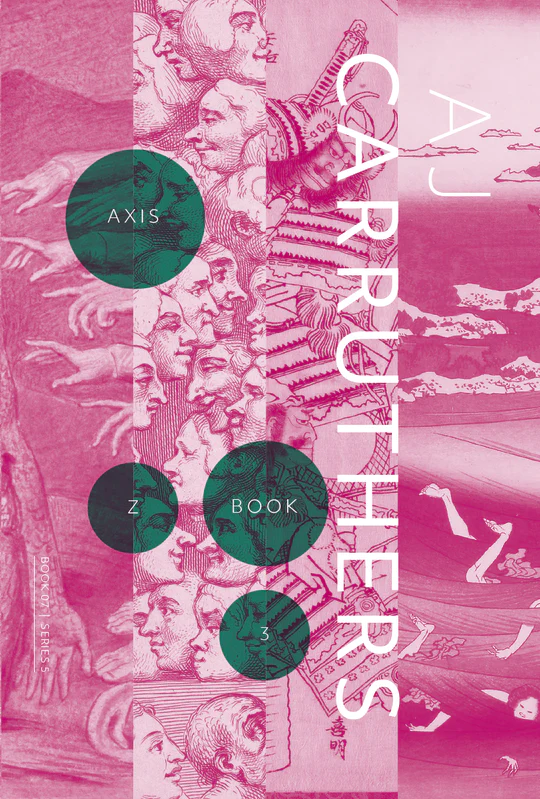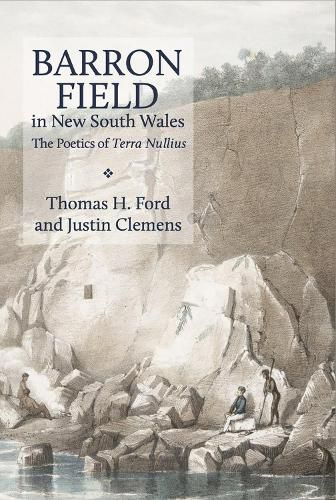For there are more letters in all languages not communicated. For there are some that have the power of sentences.
Christopher Smart, Jubilate Agno (Fragment C)
If the author of a ‘lifelong long poem’ is still alive, the poem is not finished. You’re reading the slow and irregular serialisation of a multi-decade and multi-volume work. The feeling of anticipation that new poetry publications typically inspire is incorporated into each volume of the lifelong long poem, folding the necessity of unknown future volumes into the one that is currently dozens of copies deep on the shelf in Readings. But it is at the same time muted, since this kind of project is always both promising and deferring the rest of its life.
We should be so lucky to have the moment of our death coincide with the neat fulfilment of an aesthetic project. The death of the author need not mean that the poem was finished either. Perhaps it is morbid to bring this up, but the feeling of being-towards-death is inexorably raised by the name of the form. To colour the anticipation of any given volume with the anticipation of all future volumes is to colour it with thoughts of death. Like all of us, the poem always hopes it’s just getting started.
This is the third instalment in aj carruthers’ lifelong long poem Axis. Like the enormous “A” (826 pages) by Louis Zukofsky, Axis is composed of numbered individual poems which sometimes appear alone in periodicals (a brief lifelong update), although each of the ‘axes’ has a short title and is organised into thematic sections. There is a loose alphabetising impulse at work. All the poems in the first book – Book I: ‘Areal’ – are titled with single words beginning with A: Axiality, Apex, Axiom, Act, Aria. (I check manually because there is no contents page, which seems like a missed opportunity for a graphemically pleasing paratext.) The second book repeats this procedure for axes 32 to 61, covering letters B, C, and D – with sections titled ‘Blazar’, ‘Chorastics’, and ‘Disk’. This third book, as if now aware of the distant finish line, is titled Axis Z Book 3, with four sections now proceeding in reverse alphabetical order: Zero, Yearbook (each poem is a ‘Year of …’), Xenolith, and War.
carruthers inserts and adjoins prose prefaces, glossaries, afterwords, pictures, facsimiles, and musical notation into his different instalments. Axis paratextualises, spinning out debris and satellites into numbered orbits. The result is that this new book is an extremely discontinuous assemblage that cycles through kinds of reading, modes of attention, and strategies of disambiguation. There are physical-optical challenges involved in the negotiation of the vertical line that seems to share content or structure with the parallel lines unfolding alongside it, inducing a ‘grass must be greener’ kind of reading, where skipping to the end of the poem is no longer possible because it ends four times over. To read any of these poems left to right – to wilfully break the new and perverse taboo that Axis has invented for the reader – is to encounter not the non-meaning that would normally correspond with breaking decipherment rules, but instead to illuminate some underlying structural principle, to feel the new form abstractly.
In the vast and mostly disparate collection of meaningful units arranged vertically and anti-syntactically, taxonomic genus – family resemblances, synonyms, grammar – emerges and is reassured by horizontal echo. For example, crack open poem ‘69. Zigzag’:
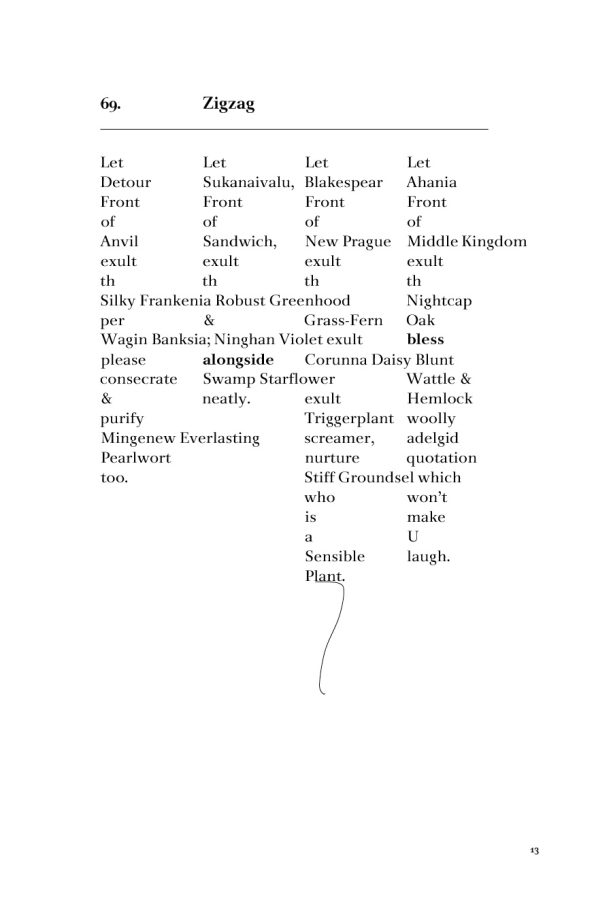
A horizontal reading feels like this:
Let Let Let Let / Detour Sukanaivalu Blakespear Ahania / Front Front Front Front / of of of of / Anvil Sandwich, New Prague Middle Kingdom / exult exult exult exult / th th th th / Silky Frankenia Robust Greenhood Grass Fern Nightcap
The repetitions index the things each line has in common, and you can tell as well that this poem is a ‘plant poem,’ stringing together various botanical nominals. It has the flavour of a Saussurean experiment, lining up synchronically identical structures – each line’s grammar is the same – in order to unveil what would normally be implicit diachronic possibility. The noun flowers into limitless plants. Most poems in Z Book 3 take this form: anaphoric ‘praise’ rhetoric via exhaustive selection and substitution, with even at times a Beckettian quality of permutation.
But the poem is not unsyntactic: I can unravel it into four quasi-Biblical exhortations whose meaning is graspable even if its referents are mysterious:
Let Detour Front of Anvil exult th Silky Frankenia per Wagin Banksia; please consecrate & purify Mingenew Everlasting Pearlwort too.
Let Sukanaivalu, Front of Sandwich, exult th Robust Greenhood & Ninghan Violet [exult] alongside Swamp Starflower neatly.
Let Blakespear Front of New Prague exult th Grass-Fern [exult] Corunna Daisy exult Triggerplant screamer, nurture Stiff Groundsel who is a Sensible Plant. [at the end of this line is a long dangling squiggle, as if drawn with the pencil tool in Photoshop, underlining and then falling away from Plant]
Let Ahania Front of Middle Kingdom exult th Nightcap Oak bless Blunt Wattle & Hemlock woolly adelgid quotation which won’t make U laugh.
I’ve marked an [exult] in square brackets where the lines overrun each other, like hanging ivy, and it’s not clear which belongs to what. The priority of unknown proper nouns troubles the Saussurean work I mentioned above, since proper nouns are broadly unsubstitutable (I guess one can have nicknames, but there’s no synonym for ‘George’) and erode the comforts of synonymy. You have to know exactly what they mean. This, and most of the other poems in Z Book 3, are a catalogue of unique referents, implying close familiarity with an enormous world, one which you’d think would be easier to decode in the internet age, but, as an avid social media user myself, I think it’s more likely that we recirculate the same proper nouns to which all the details of our life are repeatedly pinned.
This poem seems like a poetic act of documentation and invocation indulging in some Biblical parody, but the real intertext here is the poetry of Christopher Smart, whom carruthers does invoke in his preface, and who himself probably was engaged in Biblical parody (although I don’t think it’s clear to anybody what exactly Smart’s project was). In Fragment A of Jubilate Agno, Smart dives into the ‘Let …’ anaphora that carruthers picks up, writing a series of fairly long lines (in Smart it’s more like prosy free verse, while carruthers uses the vertical line to escape the prose/poetry metric distinction and refuse the natural termination points of the line-ending or page margin, thereby unfolding his lines to infinity) about the way in which God shall be praised. This consists largely of a roll call of individuals paired with a method of praise. It is ambiguous whether the method of praise is meant to elaborate the character or symbolism of the proper name, standing in for it as poetic action. At first the names will be broadly familiar to readers who grew up in countries with Christian heritage – Noah, Abraham, Isaac, Jacob, Esau – but the list soon becomes relatively esoteric – Nimrod, Ishmael, Balaam, Anah, Naphthali.
Let Tola bless with the Toad, which is the good creature of God, tho’ his virtue is in the secret, and his mention is not made.
Needless to say, you don’t need to look up every Biblical character to appreciate the poetry of Christopher Smart, and likewise I still do not know what most of the plants that carruthers invokes look like. Being in a field of unknown flowers is not hard to imagine for city slickers. Everything in the world has a unique name and you can’t be sure what it is. Every proper noun in the world has a unique thing and you can’t be sure what it is.
In Book 1, Carruthers wrote, in ‘Transcript of a Conceptual Discussion After a Performance of “Auricular”’, that ‘we read paratexts everywhere anyway. Read the terms and conditions!’ This is one of many suggestions for the reader new to this kind of experimental poetry: Axis does not tell you what you are rotating around or where your nouns come from. We are on an orbital approach vector, skimming the terms and conditions, deciphering jargons without codes.
The poems mime the text-mess dimension of contemporary experience. One animating tension is between the length of a life and its composition out of detached individual moments – but, more specifically, the charging of those moments with a permanent sense of the para- and the pre-. This is a struggle we mostly associate with novels. Poems, we are used to thinking, compose their meaningful lives out of their completed forms, their unity, their instagrammability, or the concentrated sweep of sentiment. Yet in carruthers there are only unrelieved moments, beginnings without endings. Even the grief of war is fractured into ‘supply chains / supply chains’ and ‘A / Fraction of / Fatality count lost / Fatality count lost’. These phrases repeat across the line break, as if there is nothing that they rhyme with, and yet even the familiar implications of the break (the completion of sound-patterning or sense-making) disappear into the endless, unnarrativisable column of always-breaking words. There is no ‘body’ to these poems, no hero’s journey or lyric subject, no fixed axis – no ‘text’, in a sense. Axis at its most difficult is the experience of pure paratext, or of the substitution of orbit for gravity, periphery for centre. We are always before the end. Prefaces, as Jacques Derrida put it, ‘have always been written, it seems, in view of their own self-effacement. Upon reaching the end of the pre– … the route which has been covered must cancel itself out.’ Writing a preface is being-towards-death. Axis is back-to-back preface-to-preface, a stream of ‘let …’ which blesses all things with possibility but declines enactment or representation. A poem whose noun positions flower in four directions is a poem that, while luxuriating in grammar’s fertility, finally defies grammar’s organic narrative, freezes it in rich but sterile indeterminacy. The never-ending letter never arrives at its destination.
Z Book 3 inserts the terminal letter into its title, reversing the alphabetic paratext we’ve come to expect. It’s impossible to say whether book 4 will begin with E or V. The alphabet itself is disrupted, and even the letters are de-formed into their many directions. Poem 70, ‘Ze’, is full of non-Latin variations on the theme of Z.
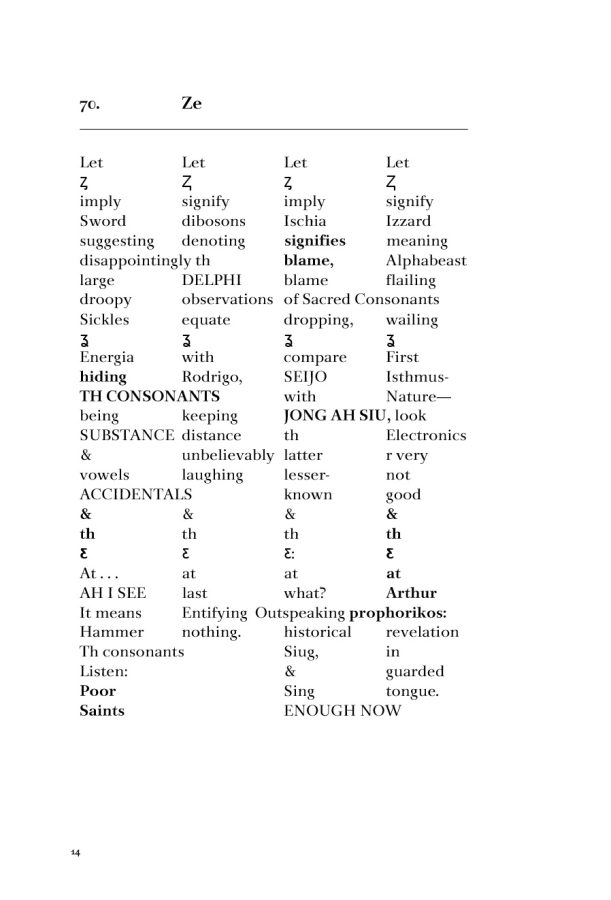
I want to google ‘Ⱬ’, which is very difficult, because I must first discover the true name of the letter, since I am not reading a PDF and cannot paste it into the search bar. Letters alone don’t signify; they compose syllables, morphemes, and words that do. The encounter with the strange letter reveals a signification that starts earlier in the cycle; there is a name for the letter, or the letter is itself a name, if you know how to write it. What is ‘A’ called? A = A.
Having thought about this, I eventually find a Wikipedia entry telling me that ‘Z with descender’ (as it turns out to be called):
is used in pre-1983 romanization of the Uyghur language, transliterating ژ [ʒ], a pre-consonantal allophone of ج /dʒ/ (see Qona Yëziq), but occurring independently in a few words of Russian, Persian or Western origin (such as ⱬurnal from journal).
I get a brief glimpse into a history about which I know very little, beyond news headlines: the romanisation of the language of an ethnic group on the periphery of modern China. A history of letters, one of the most specialised types of history, sitting next to a history of language, a history of subordinated populations, and eventually a political history, China’s, one of the greatest of the modern romanisers. I was wrong: letters do signify, which is what carruthers meant when he wrote ‘Let / Ⱬ / signify’.
I have to google ‘dibosons’ too. As I hope is becoming clear, this is what carruthers’ texts are like: thick with inexplicable reference, disunifying by signifying too enthusiastically. Wiktionary tells me that a diboson is any particle composed of two bosons. I switch to Wikipedia, because enough with the pithy definitions, and learn that a boson is one of the two fundamental subatomic particles, the other being ‘fermion.’ Fermions are the normal ones you learn about in high school: electron, proton, neutron, while bosons are the cool ones you learn about in the newspaper, the gluons (gravity) and the Higgs boson (mass). The first Wikipedia result for diboson is ‘ZZ diboson’, which seems almost too relevant to be true – even though we have long since lost sense of what relevance means, googling science words in this poetry book. It seems as if carruthers has attuned his poetry to the world wide web, so that he doesn’t need to say ‘ZZ diboson’ but knows that I will encounter it when I search it on the internet and see yet another permutation of the letter. The weak nuclear force (of the four fundamental forces, the one responsible for nuclear radiation) is mediated by W and Z bosons, and a ZZ diboson is when you have two Z bosons stuck together. It’s a rhyming couplet, I guess.
(I thought that the occurrence of DELPHI was some kind of Socratic allusion by carruthers, but it turns out that it is an acronym for DEtector with Lepton, Photon and Hadron Identification. Let it signify.)
In addition to Zs with descenders, we have Zs with hooks, ᶎ, the so-called reversed ezh, ƹ, (unrelated to the regular ezh, or Ʒ, which is the IPA symbol for the sound signified by ‘s’ in ‘vision’) based on the Arabic letter Ayin (ع), (/ʕ/ in IPA), and this thing: ʓ (Latin Small Letter Ezh with Curl), which apparently was briefly rolled out by the IPA – I am starting to realise that they are the most hard-working letter inventors of our time, those phoneticians, the true scientist-poets – to specially clarify when an ezh or an esh would be palatalised. Axis Z Book 3 is a kind of epic of the letter Z. Its form is mutated, its three strokes curved and drawn up and out. The chapter title page has a lowercase Greek zeta in a little sigil below the heading: ζ. The very letter sprawls. carruthers is working up a species of concrete poetry, letting visual forms precipitate out of his text columns. Every now and then there are little lines, flourishes, connectors, braces, and things that musicians know are called ‘slurs’, i.e. markings that tie musical objects together into a single smooth phrase: carruthers peppers Axis with these drawings, each of them potentially a little letter that got out of hand.
In poem 70, we get lines like ‘A QUOTE ZED’ and ‘WE HEARD / WHAT YOU WA ZAYIN’, which play with the fact that in English the universally standard dialogue tag – he said, she said – rhymes with, even sometimes blends into, one of the ways we pronounce our letter Z – he zed, she zed. The letter Z begins to signify speech itself. ‘Zayin’, in a further involution of this complex visual/aural/graphic/grammatic pun, is itself the word for the seventh letter of the Semitic abjads, that is, all of the Semitic writing systems that don’t specify vowels: Syriac, Phoenician, Hebrew, Aramaic, and Arabic. (I learn also from Wikipedia that ‘in Modern Hebrew slang, zayin (זין) means “penis”’).
In this book, the very idea of Z is in question in a way that would be difficult to understand in a collection of poetry that was not so difficult to understand. Correct syntax is only the most sophisticated strategy employed by letters in their own war to impose uniformity on human speech, and, by extension, on life. At least, that’s one way of making sense of the incursions that carruthers makes against syntax in this collection – or against all our habituated ways of ‘making sense’, of fitting into our boxes and inside the lines. But this critical perspective on letter-forms also allows us to understand the way that carruthers integrates musical notation into his texts – or, rather, the unique deformations and manipulations that musical notation undergoes in his hands. The final section of Z Book 3 is titled M/N Music/Notation. The acronymical title already plays up the visual half-rhyme between M and N – in the way that Roland Barthes, in S/Z, takes the desiring projection of Sarrasine and uses it to charge the very letter S itself (in the same way, I suppose, that Lacan did) with the possibility of its own castration, the possibility of it turning into something feminine, like Z(ambinella). N really is like an M with something missing – in this case, even the punctuation is contaminated with poetic double meaning, the slash looking like a disarticulated letter-piece. In ‘Death of the Author’, Barthes quotes from Balzac in order to ask: ‘who is speaking?’ Reading carruthers, ‘quoting’ one of his letter-forms, we may well ask the question: ‘who is marking?’ Is (N)otation really like (M)usic with something missing?
But then you turn the page and step into a world of complete letter-freedom – the jouissance of a disarticulated forward slash allowed to transform into a curving melodic line. At the end of Book 2, back in 2019, carruthers appended a series of ‘musical settings’, where he would set each word of a short poem under a little musical notation box, a series of distinct rectangles each containing the five lines of the standard musical staff, and draw a single squiggle across the staff in a way that suggests a pitch contour, which one could then use to intone the words. carruthers has stripped out a lot of the specific musical detail (such as a clef) that would comfort a classically trained musician, so it’s not possible to know which notes are denoted by which line of the staff. The contour is a kind of graphic music notation whose specific realisation is left to the discretion of the reader, in a manner not incompatible with the experimental graphic notation tradition of twentieth-century classical music. That being said, some of the drawn contours double back on themselves: since the right-ward progression of notes in western musical notation represents their progression forwards in time (time is on the x-axis, you might say), a note such as the one indicated for the first word of ‘Lax Music’ in Book 2, or by the many circle contours on page 90 of Z Book 3,is impossible to sing without travelling backwards in time. While this non-literal marking can confuse, it has the poetic payoff of literalising the vertical/horizontal reading rules that carruthers has been taking apart in his collection. To read horizontally in music is to obey time itself; to sing a melody that curves back on itself in graphic space is to leave time behind. carruthers has terminated Z Book 3 with a series of unheard melodies, the sounds of letters singing.
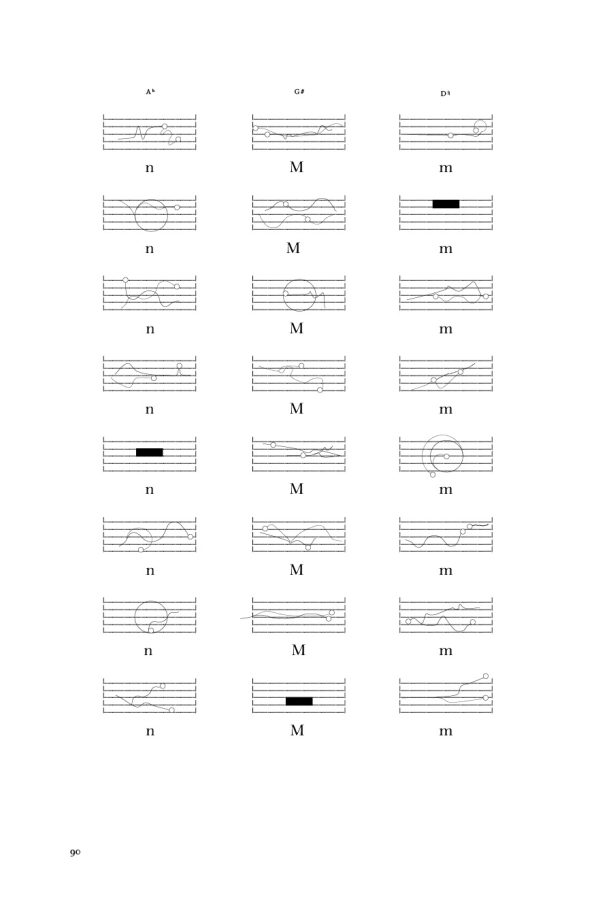
Z Book 3’s final recognisably poetic unit is something new: an ‘[Unnumbered].’ poem that will constitute the entirety of the section titled ‘War’. War occupies a recurring thematic position in carruthers’ project. The last line of the author’s preface to this instalment reads: ‘I dedicate Z Book 3 to the Peace Forces of this Earth, and to a greater material and spiritual share between nations’. What would it mean for your book of poetry to be dedicated to peace forces? ‘Peace force’ might even be a kind of oxymoron – or maybe I’m confusing it with ‘UN peacekeeper’ – and we should all be training ourselves to learn how to deploy a new kind of force in the name of justice.
Book 2 also bears a dedication at the top of the copyright page, ‘for Disarmament’. There is no dedication in Book 1: Areal, but carruthers does ask, again in the theoretically reflective interview placed midway in the collection:
Why write a simple ‘I’-poem under globalization, and assume you’re the sole subject affected by your context? Even Sappho was a supremely choral poet.
The ‘I’ is just one Axis among many, and the lifelong long poem destabilises it in the name of what is in the end a clearly defined politics: we are globalised, we are all singing with and against each other in columns of ungrammatical paratext, we are waiting for the Peace Force(r)s to arrive.
On my desk I have The Art of War by Master Sun spread out next to me as I read Z Axis 3. ‘[Unnumbered]. War’ is, like the rest of the individual poems in the book, syntactically fragmented, verticalized so that each line usually only has two or three words, typographically unstable, orthographically errant, and constantly referential, reproducing proper nouns, respelling them, hiding them beneath puns and translations. I’m constantly looking things up. Thus:
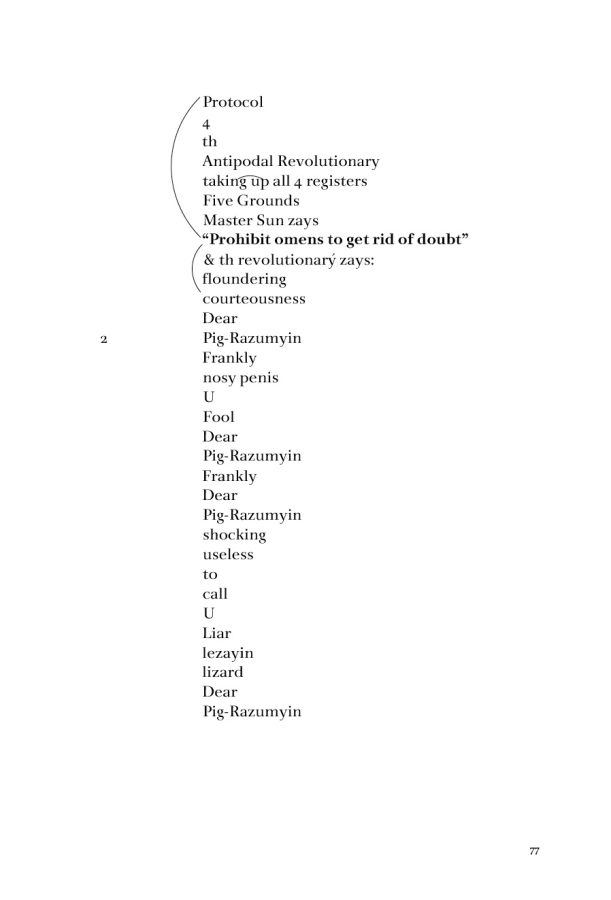
I look up the quote from Master Sun in the chapter on the Nine Situations and carefully copy down 禁祥去疑 to consult with a Chinese peer on what this instruction to a warlord might mean for contemporary Australian poetry and its revolutionaries. carruthers’ anti-syntax involves pasting phrases, words, and morphemes together in a way that overwhelms, triggers, suggests, and sometimes alights on the briefly illuminating clarity of ‘If typing doesn’t work swim vertically’ and ‘Let / Narrative go’. It licences the reader to interpret wildly whichever fragment most appeals to them.
Quoting Sun-Tzu, carruthers implies certain questions about the relationship between doubt and mysticism and false idols and state discipline and the universal army and utopian politics and the Emperor’s peace keepers, but provides no tools for answering them. I am left to speculate about the army as the little society where rules are prototyped without rebellion – voilà, for a certain Foucauldian transcoding of the poem by the critic – dropped into this poem about the many texts of war, a poem that is itself undisciplined and even unconstructed, a column of fighting words marching without margins. Is the critic a peacemaker?
In Book 1, carruthers wrote that ‘you can take any kind of language and say: this is poetry’. With Sun-Tzu on my desk, I realise that The Art of War is also a poem. It is a long preamble to a battle permanently deferred – it sets up certain possible permutations of character and location and form that are immanent to plot as such (and not just to the more politically minded Chinese classics), which I feel vaguely in the texture of failure and success that Sun-Tzu has elaborated, in an ongoing pedagogical future tense that summarises the consequences of certain wrong turns. In the chapter on the nine situations, Sun-Tzu’s advice eight out of nine times is not to fight; you fight only on desperate ground, when time contracts and strategy is over. It is a poem against war, premised on the inadvisability of conflict.
Axis shows us the poetry of this prelude to war that disavows the clash. It also shows us the poetry of plants, animals, instruments, composers, the Bible, philosophy, Yugoslavia, Melbourne, and the end of time. It has its own kind of future tense, but in Book 3 it skips to the end, and there is still a future there too. It teaches us to battle with language, with linearity, with death, and with the Latin alphabet. If Nietzsche made war against ‘truth’ in its insipid and suppressive role as the host of metaphors that glues people to their clichés and their givens, carruthers wages something similar on the terrain of type. His book is a preface to a new kind of unspeakable word, unfightable battle, and unwritable letter. You have until the publication of Book 4 to accept the terms and conditions.
